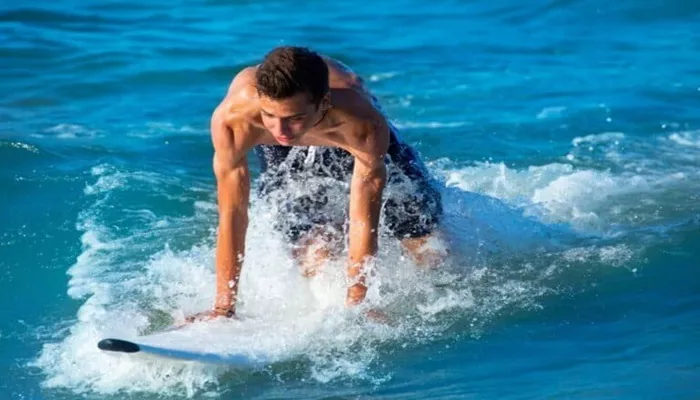The pop-up is one of the most fundamental skills in surfing. It is the transition from paddling to standing on your surfboard, and mastering this movement is essential for progressing as a surfer. A smooth, quick, and controlled pop-up allows you to catch more waves, maintain balance, and improve your overall surfing experience. However, many beginners and even intermediate surfers struggle with their pop-up, leading to missed waves, falls, and frustration.
In this guide, we’ll break down everything you need to know to improve your pop-up technique, from understanding common mistakes to developing strength, flexibility, and perfecting your form.
Understanding the Importance of A Good Pop-Up
A strong pop-up is the key to a successful takeoff. If your pop-up is slow or unsteady, you’ll struggle to control your board and maintain balance. A good pop-up ensures that:
You get into a stable stance quickly.
You maintain control when dropping into a wave.
You prevent nose-diving or falling off.
You position yourself properly for maneuvers and turns.
Now, let’s look at how to perfect your pop-up technique.
1. Master the Correct Pop-Up Technique
A proper pop-up consists of three main steps. Follow these steps to ensure a smooth transition from paddling to standing:
Push-Up Phase
Once you feel the wave lifting you, place your hands flat on the surfboard near your chest.
Keep your elbows tucked in and push your upper body off the board, similar to a push-up.
Look forward, not down, to maintain balance and awareness.
Leg Swing & Foot Placement
As you push up, swing your back foot forward first, placing it near the tail of the board.
Follow with your front foot, placing it between your hands where your chest was.
Keep your feet shoulder-width apart for stability.
Stabilize and Stand Up
Once both feet are planted, release your hands and rise into a balanced stance.
Keep your knees slightly bent and your weight centered over the board.
Keep your eyes focused ahead to maintain control.
2. Common Mistakes and How to Fix Them
Many surfers struggle with pop-ups due to a few common mistakes. Here’s what to avoid:
Pushing Up Too Slowly – A slow pop-up reduces control and can make you miss the wave. Work on building explosive upper body strength to improve speed.
Grabbing the Rails – Holding onto the sides of the board instead of pushing up from the deck can cause imbalance. Always place your hands flat on the board.
Looking Down – Looking at your feet or the board can throw off your balance. Keep your gaze forward.
Poor Foot Placement – If your feet land too close together or in the wrong position, it can make balancing difficult. Aim for a natural, shoulder-width stance.
Knees First Pop-Up – While some beginners use their knees to pop up, this habit slows progression. Focus on a single fluid motion from prone to standing.
3. Exercises to Improve Pop-Up Strength and Speed
A powerful pop-up requires strength, flexibility, and coordination. Incorporate these exercises into your routine to improve your pop-up:
Upper Body Strength
Push-Ups – Strengthen your arms, shoulders, and chest for a stronger push-up phase.
Plank Holds – Improves core strength and stability for better control.
Explosive Push-Ups – Helps develop fast-twitch muscles needed for a quick pop-up.
Core and Lower Body Strength
Squats and Jump Squats – Improves leg strength and explosive power.
Lunges – Helps with balance and leg strength.
Burpees – Mimics the pop-up motion and builds endurance.
Flexibility and Mobility
Yoga or Dynamic Stretching – Improves flexibility and range of motion.
Hip Openers – Helps you swing your legs more smoothly.
Thoracic Spine Mobility Exercises – Aids in better upper body movement.
4. Practicing Pop-Ups on Land
Perfecting your pop-up on land will make it easier to execute in the water. Here’s a step-by-step practice drill:
Find a Soft Surface – Use a yoga mat or soft ground to avoid impact injuries.
Lie Down in Paddling Position – Keep your feet together and hands positioned near your chest.
Explosive Pop-Up – Push up quickly and bring your feet into position in one smooth motion.
Hold the Stance – Stay in the surfing stance for a few seconds to build balance and muscle memory.
Repeat 10–15 Times – Repetition builds speed, strength, and coordination.
5. Practicing in the Water
Once you’ve refined your technique on land, practice in the water with these strategies:
Catch Smaller Waves First – Start with whitewash or small, rolling waves before moving to steeper waves.
Time Your Pop-Up – Paddle hard, feel the lift of the wave, and pop up just before the drop.
Stay Relaxed – Avoid tensing up; a smooth pop-up comes from staying loose and in control.
Film Yourself – Recording your sessions can help identify mistakes and areas for improvement.
6. Choosing the Right Surfboard
Your surfboard can affect how well you pop up. Consider these factors:
Beginner Boards – A larger board with more volume makes pop-ups easier.
Intermediate Boards – Shorter boards require a quicker, more explosive pop-up.
Rocker Shape – A board with more rocker (curvature) is easier to pop up on steeper waves.
Grip and Wax – Ensure your board has the right traction to prevent slipping during the pop-up.
Conclusion
Improving your pop-up is essential for becoming a better surfer. By refining your technique, avoiding common mistakes, building strength and flexibility, and practicing both on land and in the water, you can develop a faster, smoother, and more controlled pop-up. Stay patient, keep practicing, and soon, popping up will become second nature. See you in the lineup!

